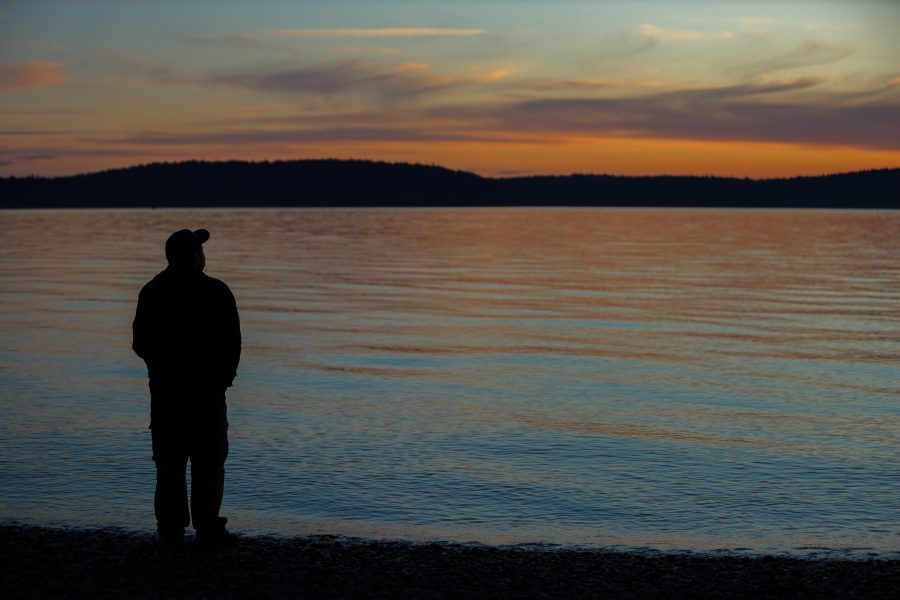Featured image: John Hemenway enjoys exploring and researching the area of Blakely Island with his class. Photo Courtesy of Daniel Wright
“My favorite experience is when we’re out for a class exercise, and we feel like we’re in the middle of nowhere, and we start to hear ‘crunch crunch crunch,’ and the whole class looks up and says, ‘What’s coming towards us? Is a deer coming towards us?’” Professor Dr. Eric Long said, smiling.
“Then John just bursts out of the woods covered in sweat, and dirt, and grime, ‘cause he’s been sliding down cliffs, or hiking through swamps, or busting through nettles, maybe some deer skulls hanging from his backpack.”
Dr. Eric Long teaches Biology and heads SPU’s deer research at the Blakely Island field station.
“It’s always a nice reminder for the class that, yes, even when we don’t see him, John is out doing his best sasquatch impersonation tromping around the woods, looking for deer.”
The “Blakely Island deer surveyor” is a mythical beast that many SPU students hear about at some point in their college career. On one of the Blakely Island class field experiences, biology students might even meet it face to face.
For the last year and a half, the beast’s name has been John Hemenway.
John Hemenway, the beast’s namesake, is an ecology major, avid hiker, photographer, and scientist. He has been involved in biology research since autumn 2017, the beginning of his sophomore year.
The research project Hemenway is part of asks how Blakely’s deer differ from deer of the same species on other islands or the mainland. By surveying deer age across locations, Hemenway discovers how long deer survive at different stages of life and island’s population density.
On Blakely, there are no natural predators to control the deer population, so food availability becomes the limiting factor in survival.
For the field portion of his research, Hemenway spends a week on Blakely at time, walking lines between sets of GPS coordinates and noting the distance and direction of deer he finds. These two-kilometer routes through marshes, nettles, cliffs, and hills are called transects.
Hemenway’s experience as a hiking guide for the Outdoor Recreation Program (ORP) at SPU made him a strong candidate for the role, and for him, deer research has been a natural bridge between his love for the outdoors and his interest in science.
But the mindset of a hiker or bushwacker only partly applies, according to Long.
“Very few folks have ever tried to hike a straight line through the woods,” Long said. “For John, it’s a survey. You’ve got to follow the straight line. Nettles or high water.”
Hemenway described his research as an opportunity to help professors answer questions but also to ask his own questions. Research is not always as straightforward as a transect.
“It’s like Pandora’s box,” Hemenway said. “You have a question you want answered, so when you start finding those answers, you have a whole other array of questions.”
Students like Hemenway act as research assistants, but they can also generate new research. Currently, many of the skulls collected by Hemenway and past deer surveyors over the last 12 years will be measured for symmetry to answer a student question about the level of inbreeding on Blakely.
Other students are trying to find methods to test DNA in the skulls of sex-ambiguous adolescent deer, which would add precision to Blakely’s deer population demographics.
Hemenway has done research with both Long and Wall-Scheffler and is on track to have completed nearly a dozen research credits by next year. His message to other students is to build relationships with professors, learn about their work, and to consider proposing their own research.
“When I see people who are interested or have a passion for stuff that I do, I try to get them to be a part of it. There aren’t a lot of people who can be doing research at any given time,” Hemenway explained. “The sooner you can get in and make a name with your professors, and stand out, the better it will be for you in the long run.”
John’s favorite memory from hiking is from when a fawn approached him on a transect near the more mountainous Blakely Peak.
“It gets within two or three feet, and it bleats. So I’m like ‘Hey there,’ and it just jumps away. Since they don’t have predators they don’t really fear people, or anything, and so it was just curious.”
“I love getting to experience nature and seeing the beauty of it, but also at the same time working on a research paper, doing actual science, and getting the question that we have answered,” said Hemenway. “I think it’s very intersectional of something I enjoy and at the same time doing science that matters and is real.”
Hemenway regrets not talking to professors earlier. “I wish I would have started freshman year. The time I wasted not doing research, I wish I could go back and change it.”
Hemenway plans to continue his deer research, both in nature and the lab, through his senior year. Another deer surveyor will be joining him for his transects next academic year.
The extra data they will collect will help further solidify the conclusions presented at 2018’s Erickson conference.
[wpvideo T94pplYq]

















































































